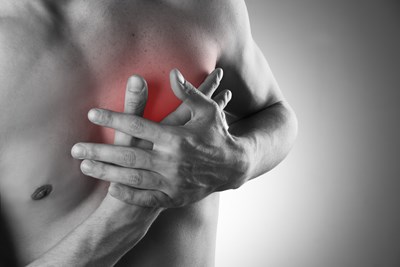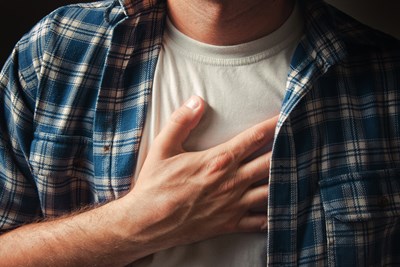Of the many types of chest pain, angina is one of the most dangerous. It results when muscles in the heart don’t receive enough oxygen. It may occur once very powerfully, or it may occur a number of times. Although the main symptoms is the aforementioned chest pain, the severity, longevity, additional symptoms, and root cause are largely dependent upon which of the four types of angina are present.
Stable Angina
In general, angina is the result of coronary heart disease, which is caused by atherosclerosis. Poor diet, obesity, smoking, and other factors cause the plaque to build up in the arteries (atherosclerosis). The blood vessels become blocked up with plaque, which makes it difficult for the blood to pass unhindered. Thus, not enough oxygen-rich blood reaches the heart, depleting the heart muscles of oxygen, and causing chest pain, which then radiates into the arms, shoulders, and jaw.
The most common type of angina is stable angina. When in a resting state, it is rarely a problem, but during times of activity, such as exercise or climbing stairs, the heart needs more oxygen. The plaque in the arteries prevents the necessary blood from flowing, causing an angina attack. The positive side of stable angina is that it is often possible to figure out exactly what triggers episodes of chest pain. Aside from physical activity, extreme cold, hearty meals, and even periods of high stress can cause the blood vessels to restrict, triggering angina. A change of lifestyle (careful exercise and a heart-healthy diet) can often help improve stable angina. Medication is often available to relieve attacks. Regardless, stable angina is indicative of a heart attack in the future.
Unstable Angina
Unstable angina, as its name suggests, is more difficult to predict. It is often more extreme and more frequent than stable angina. Physical activity is not necessarily its trigger. Chest pain from unstable angina may occur even during a resting state. The root cause also stems from atherosclerosis. However, in the case of unstable angina the ultimate cause is when the plaques burst, forming a clot which blocks blood flow. Medication is not usually helpful, and an attack of unstable angina should be considered an emergency. Because the blood flow is cut off from a clot rather than just receiving less oxygen rich blood than normal, eventually the heart muscles can die. Thus, unstable angina left untreated can result in a heart attack rather than just being a future indicator of one.
Other Types of Angina
Variant or Prinzmetal’s angina is similar to unstable angina. It is a more rare form of angina, and, like unstable angina, can occur during a resting state. A blood vessel is temporarily narrowed by a sudden spasm. Although variant angina is one of the more severe types of angina, it is generally treatable by medication. Microvascular angina often goes hand in hand with coronary microvascular disease. CMD damages small blood vessels in the heart, also causing spasms. Microvascular angina attacks are often long-lasting and extremely severe. Like stable angina, they are more likely to occur during times of physical or mental stress and can be helped by medication.



